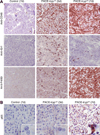Intracellular activation of trypsinogen in transgenic mice induces acute but not chronic pancreatitis
- PMID: 21471572
- PMCID: PMC4304390
- DOI: 10.1136/gut.2010.226175
Intracellular activation of trypsinogen in transgenic mice induces acute but not chronic pancreatitis
Abstract
Background and aims: Premature intra-acinar activation of trypsinogen is widely considered key for both the initiation of acute pancreatitis and the development of chronic pancreatitis. However, the biological consequences of intracellular trypsinogen activation have not been directly examined. To do so, a new mouse model was developed.
Methods: Mice were engineered to conditionally express an endogenously activated trypsinogen within pancreatic acinar cells (PACE-tryp(on)). Hallmarks of pancreatitis were determined and findings were correlated to the level (zygosity) and extent (temporal and spatial) of conditional PACE-tryp(on) expression. Furthermore, the impact of acinar cell death in PACE-tryp(on) mice was assessed and compared with a model of selective diphtheria toxin (DT)-mediated induction of acinar apoptosis.
Results: Initiation of acute pancreatitis was observed with high (homozygous), but not low (heterozygous) levels of PACE-tryp(on) expression. Subtotal (maximal-rapid induction) but not limited (gradual-repetitive induction) conditional PACE-tryp(on) expression was associated with systemic complications and mortality. Rapid caspase-3 activation and apoptosis with delayed necrosis was observed, and loss of acinar cells led to replacement with fatty tissue. Chronic inflammation or fibrosis did not develop. Selective depletion of pancreatic acinar cells by apoptosis using DT evoked similar consequences.
Conclusions: Intra-acinar activation of trypsinogen is sufficient to initiate acute pancreatitis. However, the primary response to intracellular trypsin activity is rapid induction of acinar cell death via apoptosis which facilitates resolution of the acute inflammation rather than causing chronic pancreatitis. This novel model provides a powerful tool to improve our understanding of basic mechanisms occurring during pancreatitis.
Figures







Comment in
-
Trypsinogen activation in acute and chronic pancreatitis: is it a prerequisite?Gut. 2011 Oct;60(10):1305-7. doi: 10.1136/gut.2011.241703. Epub 2011 Jun 14. Gut. 2011. PMID: 21672938 Free PMC article.
References
-
- Pandol SJ, Saluja AK, Imrie CW, et al. Acute pancreatitis: bench to the bedside. Gastroenterology. 2007;133(1056):e1–e25. - PubMed
-
- Whitcomb DC. Clinical practice. Acute pancreatitis. N Engl J Med. 2006;354:2142–2150. - PubMed
-
- Witt H, Apte MV, Keim V, et al. Chronic pancreatitis: challenges and advances in pathogenesis, genetics, diagnosis, and therapy. Gastroenterology. 2007;132:1557–1573. - PubMed
-
- Swaroop VS, Chari ST, Clain JE. Severe acute pancreatitis. JAMA. 2004;291:2865–2868. - PubMed
-
- Chiari H. Über die Selbstverdauung des menschlichen Pankreas. Z Heilk. 1896;17:69–96.
Publication types
MeSH terms
Substances
Grants and funding
LinkOut - more resources
Full Text Sources
Other Literature Sources
Molecular Biology Databases
Research Materials
